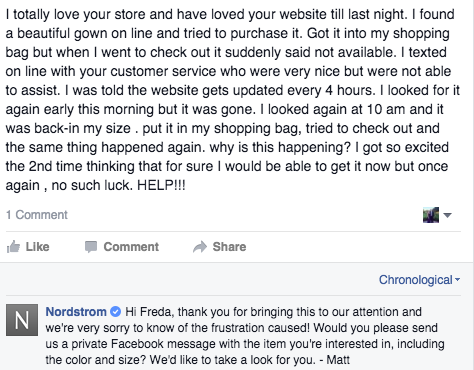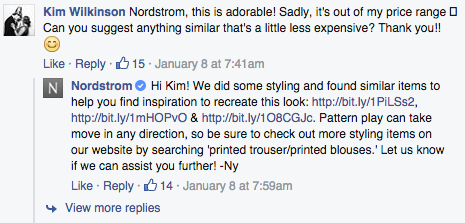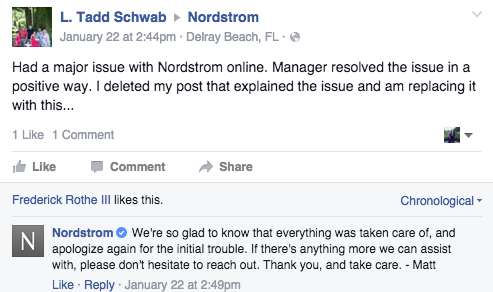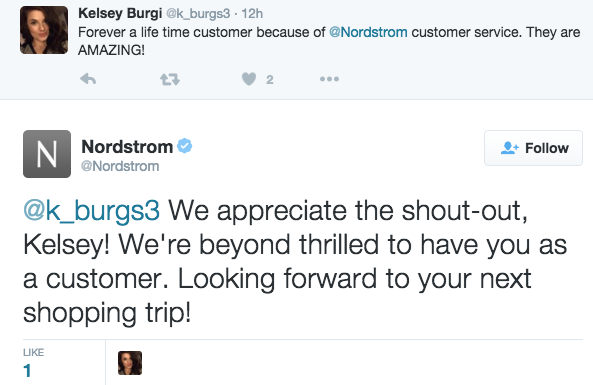Social media for many consumers is now the preferred customer service channel, and for good reason. Consumers can broadcast their complaints—and compliments—in front of hundreds or thousands of people, so brands are much more inclined to address consumers’ concerns promptly.
And consumers now expect a fast response. In fact, 32% of people anticipate a response within 30 minutes when reaching out to a brand on social media.
Nordstrom is well known for its customer service; even the employee handbook is famous. Their customer service goes beyond in-store experiences. They also are one of the most responsive and engaging brands on social media, proving that strong online customer service can foster a loyal following and tremendous growth.
Here are a few lessons from Nordstrom on how to provide exceptional customer support through your social channels.
Have a Response System In Place
Come up with a plan with the individuals who will be responsible for handling online customer service issues and requests. Think about common complaints (and praises) that arise and formulate responses.
In the example below, the customer service representative addressed the customer by name, apologized, and asked for more information in a private message. This is a common type of response you’ll see regarding similar issues across Nordstrom’s social channels.
Consistency makes it much easier to address customers’ concerns in a timely manner. Having a plan means your team will know how to respond when a question arises, and it lets your team know the chain of command when you need to get responses approved or pass an issue to another department.
Respond Quickly and Appropriately
Don’t respond just to respond. While a reasonable response time is important, replying without helping the customer can increase his or her frustration.
Typically, when Nordstrom receives a complaint regarding an order, a member of the social media team replies asking them to send a private message with their order number and contact information. I’ve seen Nordstrom reply within a few minutes, and often within the same day. Of course, the bigger your team is, the faster you are able to respond, but your team should have an agreed upon response time goal for customer issues.
In the example below, Nordstrom assisted a customer with finding affordable alternatives to a pricier item. They replied in under 20 minutes and answered her question right away; instead of saying the team would look into options and get back to her. If you can, wait and respond until you have the answer the customer is looking for. This is especially applicable when the customer doesn’t need immediate assistance.
Take Customers Offline When Possible
When a customer posts a complaint on one of your social channels, it’s important to take the conversation elsewhere. Their complaint may require them to provide you with personal information regarding an order or service, which is why you want to move the conversation to a private message, email or phone call. Never encourage customers to share private information.
In addition, this will allow you to handle your customer’s issues away from your entire Facebook or Twitter audience. Depending on the nature of the situation, the conversation may escalate and potentially damage your online brand. Your followers don’t need to see that.
Nordstrom addresses comments and concerns publicly but solves issues directly with the customer in a private message or offline.
Be Human
This is one of the best strategies your social team can implement. With social media, it can be difficult to appear human to your customers; however, showing a sense of authenticity can make a big difference. Nordstrom has its social media team sign off with their first name on Facebook. If your company has a larger social care team, this can be helpful in keeping track of who is responding to customer inquiries.
Like Nordstrom, you should also use the individual’s names when addressing him or her. Again, this shows that there are actual people behind your company’s page, and personalizes the customer service experience.
Don’t Take It Personally
Brands may be tempted to fire back at an angry customer, especially when the person is hiding behind a computer screen. In reality, it’s best to acknowledge the customer and move on. Never take down angry comments or reviews unless there are inappropriate remarks or excessive profanity. As tempting as it can be to delete a negative post, it will only make a customer more upset. And, it reflects poorly on your brand.
Turn a Complaint Into a Compliment
Use any customer interaction as an opportunity for improvement. Excellent customer service can turn an unhappy customer into a happy customer. Most of the time, customers just want to be heard. Any time you can go above and beyond to make a difference is beneficial to your brand’s reputation.
In many cases, customers complain because they want to continue buying from you. After all, they cared enough to reach out for assistance. Take the opportunity to listen, apologize, and turn an unhappy customer into a brand advocate.
Prioritizing your online customer service is a key aspect of obtaining lifelong customers. Consumers want to shop from brands that continuously provide outstanding customer service, whether that’s online or in stores.




